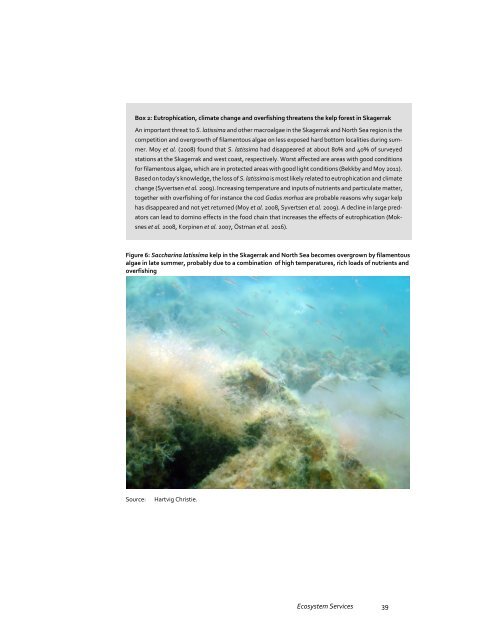Ecosystem Services
FULLTEXT01
FULLTEXT01
Create successful ePaper yourself
Turn your PDF publications into a flip-book with our unique Google optimized e-Paper software.
Box 2: Eutrophication, climate change and overfishing threatens the kelp forest in Skagerrak<br />
An important threat to S. latissima and other macroalgae in the Skagerrak and North Sea region is the<br />
competition and overgrowth of filamentous algae on less exposed hard bottom localities during summer.<br />
Moy et al. (2008) found that S. latissima had disappeared at about 80% and 40% of surveyed<br />
stations at the Skagerrak and west coast, respectively. Worst affected are areas with good conditions<br />
for filamentous algae, which are in protected areas with good light conditions (Bekkby and Moy 2011).<br />
Based on today’s knowledge, the loss of S. latissima is most likely related to eutrophication and climate<br />
change (Syvertsen et al. 2009). Increasing temperature and inputs of nutrients and particulate matter,<br />
together with overfishing of for instance the cod Gadus morhua are probable reasons why sugar kelp<br />
has disappeared and not yet returned (Moy et al. 2008, Syvertsen et al. 2009). A decline in large predators<br />
can lead to domino effects in the food chain that increases the effects of eutrophication (Moksnes<br />
et al. 2008, Korpinen et al. 2007, Östman et al. 2016).<br />
Figure 6: Saccharina latissima kelp in the Skagerrak and North Sea becomes overgrown by filamentous<br />
algae in late summer, probably due to a combination of high temperatures, rich loads of nutrients and<br />
overfishing<br />
Source:<br />
Hartvig Christie.<br />
<strong>Ecosystem</strong> <strong>Services</strong> 39


